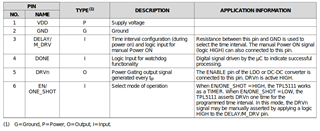Hello guys,
One of my customers is going to evaluate TPL5111 for their new products.
At this moment, the customer has the following question.
Could you please give me your reply for them?
Q. They want to insert a resistor between EN/ONE_SHOT terminal (No. 6) and GND as a pull down resistor
like the circuit in the following blog.
https://www.instructables.com/Solar-and-Battery-Powered-Timed-Shed-LED-Light/
They have already confirmed that TPL5111 worked correctly when the resistor range was 0ohm ~ 820kohm.
Is it no problem to insert the pull down resistor?
Your reply would be much appreciated.
Best regards,
Kazuya.




